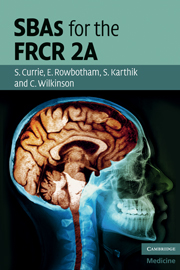Book contents
- Frontmatter
- Contents
- List of contributors
- Preface
- Introduction
- Module 1 Cardiothoracic and vascular
- Module 2 Musculoskeletal and trauma
- Module 3 Gastro-intestinal
- Module 4 Genito-urinary, adrenal, obstetrics & gynaecology and breast
- Questions
- Answers
- Module 5 Paediatric
- Module 6 Central nervous and head & neck
- References
- Index
Questions
Published online by Cambridge University Press: 06 July 2010
- Frontmatter
- Contents
- List of contributors
- Preface
- Introduction
- Module 1 Cardiothoracic and vascular
- Module 2 Musculoskeletal and trauma
- Module 3 Gastro-intestinal
- Module 4 Genito-urinary, adrenal, obstetrics & gynaecology and breast
- Questions
- Answers
- Module 5 Paediatric
- Module 6 Central nervous and head & neck
- References
- Index
Summary
1. A 40 year old mother of three presents with menorrhagia and dysmenorrhoea. Transvaginal ultrasound shows an enlarged uterus with focal heterogeneous myometrial echotexture. The endometrium appears widened. T2-weighted MR imaging demonstrates focal widening of the junctional zone. There is a hypointense elongated myometrial mass with ill-defined margins. The mass contains foci of high signal on both T1- and T2-weighted imaging. The mass demonstrates contrast enhancement but to a lesser degree than the surrounding myometrium. What is the most likely diagnosis?
a. Leiomyoma
b. Endometrial carcinoma
c. Adenomyosis
d. Fibroma
e. Haematoma
2. A 42 year old woman presents with post-coital bleeding. Transvaginal ultrasound shows the cervix to be enlarged, irregular and hypoechoic. MRI demonstrates a large cervical cancer with involvement of multiple pelvic lymph nodes. The left kidney is hydronephrotic. What is the most appropriate staging based on these findings?
a. T1
b. T2b
c. T3a
d. T3b
e. T4
3. A 50 year old woman presents with pelvic pain and abdominal fullness. Ultrasound reveals ascites and a large hypoechoic ovarian mass with posterior acoustic enhancement. CT demonstrates a well-defined solid pelvic mass which shows poor contrast enhancement. There is also a right-sided pleural effusion. Follow-up imaging post-surgical resection shows no residual tumour and resolution of ascites.
- Type
- Chapter
- Information
- SBAs for the FRCR 2A , pp. 75 - 87Publisher: Cambridge University PressPrint publication year: 2010



